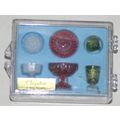London - St. Pauls, Covent Garden - art postcard c.1950s
- Condition : Used
- Dispatch : 2 Days
- Brand : None
- ID# : 182680740
- Quantity : 1 item
- Views : 105
- Location : United Kingdom

- Seller : justthebook (+1704)
- Barcode : None
- Start : Wed 19 Jun 2019 20:28:26 (EDT)
- Close : Run Until Sold
- Remain : Run Until Sold
Checks/Cheques
 for 1 item(s) edit
for 1 item(s) edit
Shipping Calculator
More Listings from This Seller view all
Seller's Description
- Postcard
- Picture / Image: St. Paul's, Covent Garden - sketch
- Publisher: none stated, c.1950s
- Postally used: no
- Stamp: n/a
- Postmark(s): n/a
- Sent to: n/a
- Notes / condition:
Please ask if you need any other information and I will do the best I can to answer.
Image may be low res for illustrative purposes - if you need a higher definition image then please contact me and I may be able to send one. No cards have been trimmed (unless stated).
------------------------------------------------
Postage & Packing:
Postage and packing charge should be showing for your location (contact if not sure).
No additional charges for more than one postcard. You can buy as many postcards from me as you like and you will just pay the fee above once. Please wait for combined invoice. (If buying postcards withother things such as books, please contact or wait for invoice before paying).
Payment Methods:
UK - PayPal, Cheque (from UK bank) or postal order
Outside UK: PayPal ONLY (unless otherwise stated) please. NO non-UK currency checks or money orders (sorry).
NOTE: All postcards are sent in brand new stiffened envelopes which I have bought for the task. These are specially made to protect postcards and you may be able to re-use them. In addition there are other costs to sending so the above charge is not just for the stamp!
I will give a full refund if you are not fully satisfied with the postcard.
----------------------------------------------
Text from the free encyclopedia WIKIPEDIA may appear below to give a little background information (internal links may not work) :
*************
St Paul's Church is a church in Covent Garden, London, England, designed by Inigo Jones as part of a commission for the 4th Earl of Bedford in 1631 to create "houses and buildings fitt for the habitacons of Gentlemen and men of ability".[1] As well as being the parish church of Covent Garden, the church has gained the nickname of "the actors' church"[2] by a long association with the theatre community.
Completed in 1633, St Paul's was the first entirely new church to be built in London since the Reformation.[3] Its design and the layout of the square have been attributed to Inigo Jones since the 17th century, although firm documentary evidence is lacking.[4] According to an often repeated story, recorded by Horace Walpole, Lord Bedford asked Jones to design a simple church "not much better than a barn", to which the architect replied "Then you shall have the handsomest barn in England".[5]
The building is described by Sir John Summerson as "a study in the strictly Vitruvian Tuscan Order" and "almost an archaeological exercise".[6][3] The description of a Tuscan or Etruscan-style temple in Vitruvius,[7] which Jones closely follows in this building, reflects the early forms of Roman temple, which essentially continued Etruscan architecture, though quite what Vitruvius intended by his account has divided modern scholars.[8] It has been seen as a work of deliberate primitivism: the Tuscan order is associated by Palladio with agricultural buildings.[3]
In 1630, the 4th Earl of Bedford was given permission to demolish buildings on an area of land he owned north of the Strand, and redevelop it. The result was the Covent Garden Piazza, the first formal square in London. The new buildings were classical in character. At the west end was a church, linked to two identical houses. The south side was left open.[3]
Work on the church was completed in 1633, at a cost of to Bedford estate of £4,886, but it was not consecrated until 1638 due to a dispute between the earl and the vicar of St Martin-in-the-Fields. It remained a chapel within the parish of St Martin-in-the-Fields until 1645, when Covent Garden was made a separate parish and the church dedicated to St. Paul.[4]
In 1789 there was a major restoration of the church, under the direction of the architect Thomas Hardwick.[4] Six years later, in September 1795, the church was burnt out by a fire, accidentally started by workmen on the roof.[9] A survey of the damage found that the outer walls were still structurally sound, but that the portico would have to be reconstructed. It is unclear whether this was in fact done. Having been restored once more, again under Hardwick's supervision, the church was reconsecrated on 1 August 1798.[4] Despite the destruction, the parish records were saved, as was the pulpit — the work of Grinling Gibbons.[10]
The puritan Thomas Manton ministered from the pulpit of St Paul's until the Great Ejection. On 23 September 1662 Simon Patrick, later Bishop of Ely, was preferred to the rectory of St. Paul’s where he served during the plague.
The first known victim of the 1665–1666 outbreak of the Plague in England, Margaret Ponteous, was buried in the churchyard on 12 April 1665.
The east end, facing the piazza, is faced in stone, with a massive portico, its boldly-projecting pediment supported by two columns and two piers. There were originally three doorways behind the portico; the middle one, which survives, was built as a false door as the interior wall behind it is occupied by the altar.[9] The other two were blocked up in the 19th century, when the chancel floor was raised.[4] The main entrance to the church is through the plainer west front, which has a pediment, but no portico.[9] William Prynne, writing in 1638 said that it was originally intended to have the altar at the west end, but pressure from the church hierarchy led to the imposition of the traditional orientation.[4]
The earliest existing detailed description, dating from 1708, says that the exterior was not of bare brick, but rendered with stucco. In 1789 it was decided to case the walls in Portland stone as part of a major programme of renovation, which Thomas Hardwick was chosen to supervise. At the same time the tiled roof was replaced with slate, the dormer windows, added in the 1640s, were removed,[4] and the archways flanking the church, originally of stuccoed brick, were replaced with stone replicas.[9] When Hardwick's stone facing was removed from the church in 1888; it was found to be a thin covering less than three inches thick, poorly bonded to the brick. The building was then reclad in the present unrendered red brick.[4]
There were originally six or seven steps leading up to the portico, but these disappeared as the level of the Piazza was raised gradually over the years. By 1823 there were only two steps visible, and none by 1887.[4] The arches at the side of the portico were substantially widened and raised during a restoration of 1878–82 by Henry Clutton,[11] The 9th Duke of Bedford's architect.[4] Clutton also removed the bell-turret over the western pediment.[11]
The interior is a single space, undivided by piers or columns. The eastern third was originally marked out as a chancel by means of the floor being raised by one step. The level was raised further during
Listing Information
| Listing Type | Gallery Listing |
| Listing ID# | 182680740 |
| Start Time | Wed 19 Jun 2019 20:28:26 (EDT) |
| Close Time | Run Until Sold |
| Starting Bid | Fixed Price (no bidding) |
| Item Condition | Used |
| Bids | 0 |
| Views | 105 |
| Dispatch Time | 2 Days |
| Quantity | 1 |
| Location | United Kingdom |
| Auto Extend | No |





















